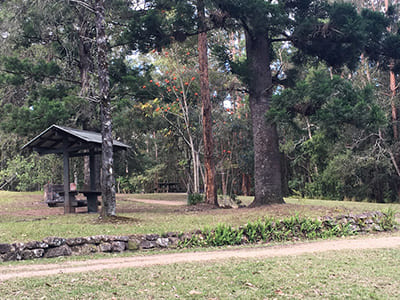
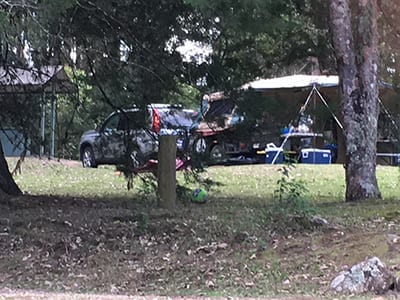
(left)The campground looks like a park at first glance.(right)A family of five already had this tent set up when we arrived. They lent us their axe to chop wood for our campfire, and we quickly became friends after asking where they were from. Interactions like these are one of the real charms of camping in Australia.
These are the signs posted at the campground. The one on the right has small envelopes available pre-printed with the destination address on copy paper with a perforation down the middle. It tells you to fill that area out with your name, vehicle plate number, postal code, the number of children and adults, and how long you’ll be staying. You then tear off the top copy at the dotted line, displaying the portion labeled Vehicle Fee in your vehicle and the one marked Camping Fee in a visible place on your tent. It then asks you to put the money in the envelope and put it in the small box shown in the picture. Someone comes around to check on it every once in a while, but it’s basically an unstaffed campground where the campers do everything themselves. The fees, by the way, are AUD 6 per adult (about JPY 475), with a vehicle entry fee of AUD 8 (about JPY 630).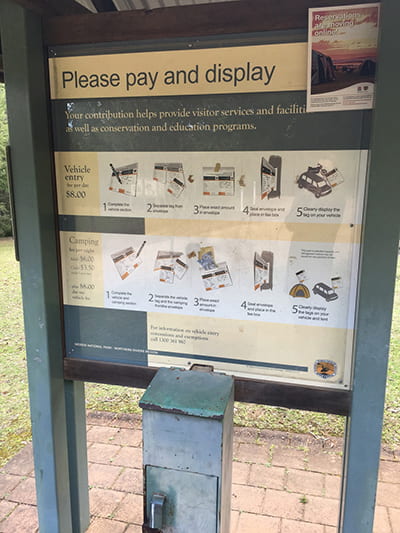
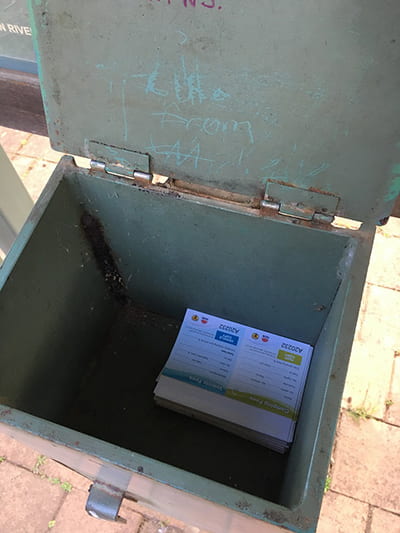
(left)The sign clearly explained how to use the system.(right) You could find the envelopes by opening the lid of the small box in the lower part of the photo on the left. Unfortunately, there was no pen.
The campground also only had one toilet. Surprisingly, though, it was well-stocked with toilet paper. The sink for handwashing used rainwater, so it had a sign telling people not to drink it. In a country where water is so precious, you could open the tap all the way and no more than a tiny thread of water would come out.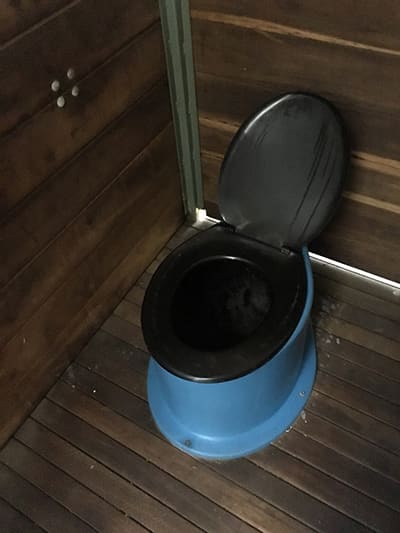
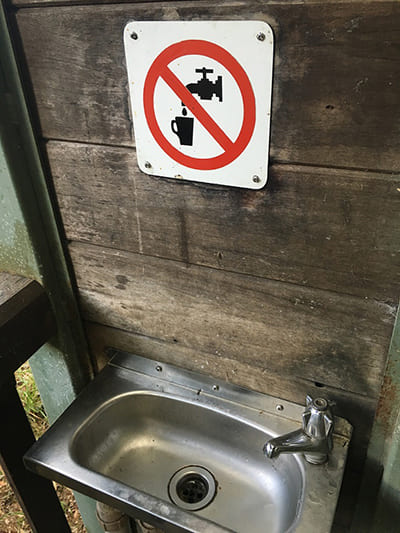
(left)The campground had a relatively clean vault toilet.(right)The handwashing station only offered a trickle of water at full blast.

REPOTER

- Chieko Suganuma (maiden name : Nagura)
- JobCompany employee
She moved to Australia in 2000. She worked for a Japanese-affiliated travel agency, and then started her current position at a construction company in 2014.On her days off, she enjoys making soy candles that is a hobby of mine and walking on the beach.She hope to share rare lifestyle information from the local area with you.
What's New
-

- 2025.12.19
- A four-day trip to Tasmania, featuring wineries and breweries
- Sydney( Australia )
-

- 2025.12.18
- Blog Liguria - Bizarre Vending Machines
- Genoa( Italy )
-

- 2025.12.17
- More and More Ice Cream Parlors are Opening
- Sao paulo( Brazil )
-

- 2025.12.09
- The least-Italian city in Italy
- Milan( Italy )
-

- 2025.12.08
- Dover cliffs
- London( UK )
-

- 2025.12.05
- Returning to Japan After Ten Years: Can You Feel Homesick for a Foreign Country?
- Bishkek( Kyrgyz Republic )
REPORTER
-

- Hiroko Fujita
- SydneyAustralia
-

- Patrizia Margherita
- GenoaItaly
-

- Nami Minaki Sandra
- Sao pauloBrazil
-

- Yuriko Mikami
- MilanItaly
-

- GianFranco Belloli
- LondonUK
-

- Daniiar Bakchiev
- BishkekKyrgyz Republic
-

- Shoko Yamamoto
- ParacasPeru
-

- Megumi Ota
- Santo_isidoroPortugal
-

- Chieko Suganuma (maiden name : Nagura)
- Gold CoastAustralia
-

- Susumu Yamada
- MadridSpain
-

- Patrick Sacco
- Austin, TexasU.S.A
-

- Alberto Ferrando
- SydneyAustralia
-

- Patrizia Margherita
- PortlandU.S.A
-

- Chuleeporn Suksabye
- Chiang MaiThailand
-

- Padra Rivodo Hiromi
- MonterreyMexico
-

- Erika Anderson
- CarmelU.S.A
-

- Keiko Miki
- DublinIreland
-

- Knowledge Capital Staff
- Japan-townJapan
-

- Rim
- DusseldorfGermany
-

- Claudia Diaz
- New YorkU.S.A
-

- Zia Fariya
- BangaloreIndia
-

- Mara Groner
- BerlinGermany
-

- Lisanne Kleinjan
- RotterdamNetherlands
-

- Christine Pilcavage
- MassachusettsU.S.A
-

- Martha Hickey
- MichiganU.S.A
-

- Mirai Tsuda
- FirenzeItaly
-

- Kazuya Yamaoka
- MontereyU.S.A
-

- Takae Nagamiya
- Los AngelesU.S.A
-

- Kazuhito Habu
- BerlinGermany
-

- Sanja Bogetic
- BelgradeSerbia
-

- Sarena Ehrlich
- FontainebleauFrance
-

- Yves Lalune
- DijionFrance
-

- Martha Hickey
- AmsterdamNetherlands
-

- Hiroshi Yamauchi
- VilniusLithuania
-

- Ritsuko Derickson
- WashingtonD.C.U.S.A
-

- Rei Watanabe
- BerlinGermany
-

- Tatsuji Seki
- BangkokThailand
-

- Rubin Cynthia Beth
- New HavenU.S.A
-

- Miho Bokuda
- FirenzeItaly
-

- Pat Lee
- Hong kongChina
-

- Weikalossu Lin
- TaichungTaiwan
-

- Emiko Ogawa
- LinzAustria
-

- Hironari Masuda
- ShanhaiChina
What's New
-

- 2025.12.19
- A four-day trip to Tasmania, featuring wineries and breweries
- Sydney( Australia )
-

- 2025.12.18
- Blog Liguria - Bizarre Vending Machines
- Genoa( Italy )
-

- 2025.12.17
- More and More Ice Cream Parlors are Opening
- Sao paulo( Brazil )
-

- 2025.12.09
- The least-Italian city in Italy
- Milan( Italy )
-

- 2025.12.08
- Dover cliffs
- London( UK )
-

- 2025.12.05
- Returning to Japan After Ten Years: Can You Feel Homesick for a Foreign Country?
- Bishkek( Kyrgyz Republic )












